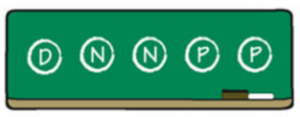Coin and Bill Combinations
Purpose
To count a collection of coins to find the total amount.
Materials
None
Overview
Write a combination of coins on the board, using shorthand notation to represent each coin by writing the first letter of its name. For example:

Then, ask children how much the collection of coins is worth. (22¢). Repeat as necessary. As children become confident in counting a collection of coins to find the total amount, begin to vary the exercise. For example, cross out one of the coins, a penny, and ask how much the coins are worth now. (21¢). Add another coin, such as a nickel, and ask how much the coins are worth. (26¢) Add $1 using the symbol ![]() , and ask for the value of the collection now. ($1.26) Continue adding and removing coins and bills and having children identify the value of the combinations.
, and ask for the value of the collection now. ($1.26) Continue adding and removing coins and bills and having children identify the value of the combinations.
About the sequence
Part 1—counting collections of dimes, nickels, and pennies (tens, fives, and ones)—is likely familiar. Part 2 includes quarters and adding and removing coins to calculate a new total. The extension incorporates dollars and continues adding and removing coins to calculate a new total.
Part 1
I’m going to draw a collection of dimes, nickels, and pennies. How many cents do I have in all?
Examples:
- Draw 5 dimes, 3 nickels, 7 pennies. How many cents do we have? (72¢).
- Draw 3 dimes, 1 nickel, and 1 penny. How many cents do we have? (96¢)
- Draw 7 dimes, 2 nickels, 3 pennies. How many cents do we have now? (83¢)
If children need more practice or are enjoying their mastery, repeat. If children are ready to move on, go to Part 2.
Part 2
I’m going to draw a collection of quarters, dimes, nickels, and pennies. How many cents do I have in all? How many cents do we have if I cross off _______? How many cents do we have if I draw ________?
Examples:
- Draw 3 quarters, 1 dimes, 3 nickels (95¢).
- Cross off 1 quarter, 1 dime, 1 nickel. (55¢) How many cents do I have now?
- Draw 2 quarters and 6 pennies. ($1.11 or 111¢) How many dollars and cents do I have now?
If children need more practice, repeat. Or, when children seem excited for a new challenge, move to the extension.
Extension
I’m going to draw a collection of dollars, quarters, dimes, nickels, and pennies. How many cents do I have in all? How many cents do we have if I draw ________? How many cents do we have if I cross off _______?
Examples:
- Draw 2 dollars, 2 quarters, 3 dimes, 1 nickel, 1 penny ($2.86).
- Draw 3 dollars and 6 pennies. ($5.92) How many dollars and cents do I have now?
- Cross off 8 dimes, 2 nickels, 2 pennies. ($5.00) How many dollars and cents do I have now?

This work is licensed under a
Creative Commons Attribution-NonCommercial-NoDerivatives 4.0 International License.
